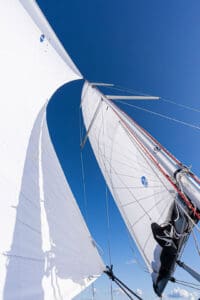
We see a boat over on its beam ends in a blow and say “they’re over canvased.” But, of course, sails are no longer made of cotton-based canvas. They’re woven from synthetic materials derived from petroleum. Now North Sails has announced a new sail fabric called RENEW that’s almost entirely made from recycled materials. And in Europe, Danish sailmaker Elvstrom offers a sail it calls EKKO also made from recycled plastic. For cruisers who wish to reduce their overall voyaging footprint, new sailcloth products like these can be an attractive choice.
North calls its RENEW product a North Paneled Laminate sailcloth that’s intended for cruising boats in the range of 25 to 45 feet. The cloth is made from more than 90% sustainable sources. And according to North, using these materials results in no sacrifice in performance or longevity compared to sailcloth made from new materials.
Tom Davis, North Sails RENEW product director explains that the road to this new product started roughly four years ago when Davis and others at North met with the company that supplies North with polyester films.
“Our supplier mentioned that they had a recycled source made from discarded beverage bottles. My immediate reaction was it probably wasn’t something we can use because typically when you melt down a bottle and filter out the junk, the plastic quality goes down every time you do that.”
It turned out, however, that the supplier was using a far superior process that recycled the material to its base chemical that was then used to make new film. “Chemically and mechanically their recycled product line is exactly the same performance as the best stuff they make that we’ve always used,” Davis said.
Voyagers often buy sails based not solely on performance like racing sailors. For most voyaging budgets the key is balancing solid performance with cost/durability. Since cruising sails will generally be used in a wide variety of conditions and for an extended time, many voyagers opt for a tried and true sailcloth like Dacron. This common sail fabric is woven from fibers made from a material called polyethylene terephthalate, a polymer devised by the polyestrification (there’s a word for you) of ethylene glycol and terephthalic acid. It was first concocted in a research lab in Lancashire, UK in 1941 by British chemist J.R. Whinfield. Later the British company ICI began producing this material and in 1946 trademarked it Terylene, a name which used the first syllable of terephthalic and the last syllable of ethylene and inverted the order. The American chemical giant Dupont purchased the U.S. rights from ICI and renamed it Dacron. In 1950 DuPont opened the first factory devoted solely to producing Dacron in Kinston, N.C.
In recent years we’ve seen the increasing use of other advanced polymers for sailcloth: Mylar, Kevlar, (developed by DuPont chemist Stephanie Kwolek in 1965); Technora, Spectra and Dyneema. These materials are higher in cost and thus are more likely to be used for racing sails than for sails on the standard liveaboard voyaging sailboat.
As for RENEW, after that meeting with its polyester film supplier North began using the recycled film product in some of its sails, but without announcing it as a new product. When people inside and outside company heard of the use of this recycled material, the reaction was overwhelmingly positive. “And that’s what kind of evolved into looking at yarn taffetas, high modulus fiber and so on,” Davis said, “to see what else we could do without compromising performance.”
In addition to polyesters from recycled plastic like beverage bottles, RENEW sailcloth also uses a bio-based Dyneema fabric, provided by another supplier, in the RENEW mix. “Instead of cracking petroleum to extract the ethylene,” Davis said, “they basically destructively distill pulp wood trees [to get ethylene] and make a very high strength high modulus fiber.”
Given this was a new approach to sailmaking for North, the company wanted to make sure the new material was suitable. “It starts with vetting the material in the lab and then we run trials in our laminate and 3Di processes,” Davis said. “We have a lot of equipment in the company that simulates what a sail material goes through in the real world. We get tons of UV on it and pull on it. If it passes that then we turn it into a sail material.” Davis had a RENEW sail built for his boat that allowed him to test it on the water. The new sailcloth was also sent various other boatowners in Europe and North America for further testing. “I’m a hundred percent confident that in terms of durability and performance these materials are going be just the same as if they were built from less sustainable materials.”
If there is one downside to the new RENEW sails, its that they do carry a higher price. As Davis put it, however, “…if you could have a sail that performs as well and doesn’t cost much more and lasts a long time but has a more sustainable footprint,” many voyaging sailors will likely take that trade off. Sustainable sails fit the desire of many voyagers to take a low impact approach to voyaging.

